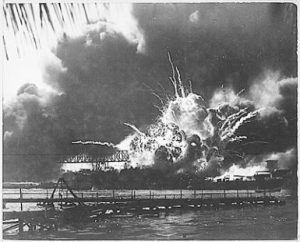For more than two years after World War II started in Europe, Americans debated what U.S. policy should be toward the Axis Powers. Anti-interventionist leaders bitterly denounced what they saw as an unnec essary involvement by the US in the affairs of Europe.
essary involvement by the US in the affairs of Europe.
The public debate was finally settled on Sunday December 7, 1941 when Japanese planes attacked the U.S. naval base at Pearl Harbor in Hawaii. The attack started at 7:55 AM and lasted 110 minutes. To aid their airplanes, the Japanese sent in five midget subs to help target the battleships. The Americans sunk four of the midget subs and captured the fifth.
A total of 2,335 U.S. servicemen were killed and 1,143 were wounded. Sixty-eight civilians were also killed and 35 were wounded. The Japanese lost 65 men, with an additional soldier being captured.
The U.S. also lost eighteen ships, including eight battleships, and about 300 planes. The United States aircraft carriers, the primary target of the attack, were not at the base at the time. Because of this, the Japanese cancelled a planned second attack. There were eight battleships at Pearl Harbor that day, which included all but one of the battleships of the U.S. Pacific fleet. All eight were either sunk or damaged during the attack. Amazingly, all but two (the Arizona and the Oklahoma) were eventually able to return to active duty.
The next day, Roosevelt addressed a joint session of Congress, called the attack “a date which will live in infamy,” and demanded a declaration of war. A near unanimous (one dissenting vote) Congress gave it to him. On December 11, Germany, Japan’s ally, declared war on the U.S. By the end of the day, the U.S. Congress had, at FDR’s request, returned the favor. The United States was finally in World War II.
Information from: Ten Historical Anniversaries in 2016 by James M. Lindsay 12/1/2015 and
Pacific warbirds.com and History.com
